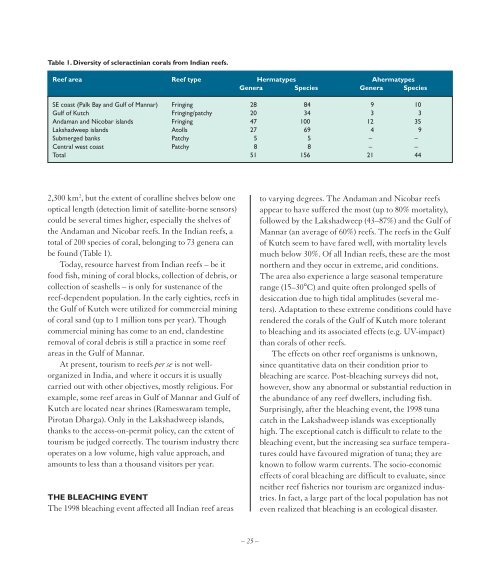Create successful ePaper yourself
Turn your PDF publications into a flip-book with our unique Google optimized e-Paper software.
Table 1. Diversity of scleractinian corals from Indian reefs.<br />
Reef area Reef type Hermatypes Ahermatypes<br />
Genera Species Genera Species<br />
SE coast (Palk Bay and Gulf of Mannar) Fringing 28 84 9 10<br />
Gulf of Kutch Fringing/patchy 20 34 3 3<br />
Andaman and Nicobar islands Fringing 47 100 12 35<br />
Lakshadweep islands Atolls 27 69 4 9<br />
Submerged banks Patchy 5 5 – –<br />
Central west coast Patchy 8 8 – –<br />
Total 51 156 21 44<br />
2,300 km 2 , but the extent of coralline shelves below one<br />
optical length (detection limit of satellite-borne sensors)<br />
could be several times higher, especially the shelves of<br />
the Andaman and Nicobar reefs. In the Indian reefs, a<br />
total of 200 species of coral, belonging to 73 genera can<br />
be found (Table 1).<br />
Today, resource harvest from Indian reefs – be it<br />
food fish, mining of coral blocks, collection of debris, or<br />
collection of seashells – is only for sustenance of the<br />
reef-dependent population. In the early eighties, reefs in<br />
the Gulf of Kutch were utilized for commercial mining<br />
of coral sand (up to 1 million tons per year). Though<br />
commercial mining has come to an end, clandestine<br />
removal of coral debris is still a practice in some reef<br />
areas in the Gulf of Mannar.<br />
At present, tourism to reefs per se is not wellorganized<br />
in India, and where it occurs it is usually<br />
carried out with other objectives, mostly religious. For<br />
example, some reef areas in Gulf of Mannar and Gulf of<br />
Kutch are located near shrines (Rameswaram temple,<br />
Pirotan Dharga). Only in the Lakshadweep islands,<br />
thanks to the access-on-permit policy, can the extent of<br />
tourism be judged correctly. The tourism industry there<br />
operates on a low volume, high value approach, and<br />
amounts to less than a thousand visitors per year.<br />
THE BLEACHING EVENT<br />
The 1998 bleaching event affected all Indian reef areas<br />
to varying degrees. The Andaman and Nicobar reefs<br />
appear to have suffered the most (up to 80% mortality),<br />
followed by the Lakshadweep (43–87%) and the Gulf of<br />
Mannar (an average of 60%) reefs. The reefs in the Gulf<br />
of Kutch seem to have fared well, with mortality levels<br />
much below 30%. Of all Indian reefs, these are the most<br />
northern and they occur in extreme, arid conditions.<br />
The area also experience a large seasonal temperature<br />
range (15–30°C) and quite often prolonged spells of<br />
desiccation due to high tidal amplitudes (several meters).<br />
Adaptation to these extreme conditions could have<br />
rendered the corals of the Gulf of Kutch more tolerant<br />
to bleaching and its associated effects (e.g. UV-impact)<br />
than corals of other reefs.<br />
The effects on other reef organisms is unknown,<br />
since quantitative data on their condition prior to<br />
bleaching are scarce. Post-bleaching surveys did not,<br />
however, show any abnormal or substantial reduction in<br />
the abundance of any reef dwellers, including fish.<br />
Surprisingly, after the bleaching event, the 1998 tuna<br />
catch in the Lakshadweep islands was exceptionally<br />
high. The exceptional catch is difficult to relate to the<br />
bleaching event, but the increasing sea surface temperatures<br />
could have favoured migration of tuna; they are<br />
known to follow warm currents. The socio-economic<br />
effects of coral bleaching are difficult to evaluate, since<br />
neither reef fisheries nor tourism are organized industries.<br />
In fact, a large part of the local population has not<br />
even realized that bleaching is an ecological disaster.<br />
– 25 –


















